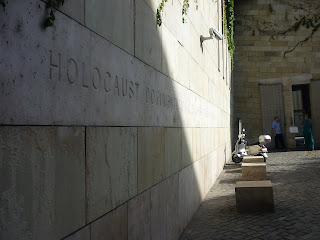Not only is Budapest a gorgeous city, looking even more beautiful in the hot weather we were blessed with, but it was once somewhat Hungary's answer to Nazi Germany. The Fascist Arrow Cross Party sprung up in the country and ruled in government from 1944-1945. They shared many of the Nazis' principles and were only too ready to help deport and exterminate as many Hungarian Jews as possible. Thanks to the Arrow Cross Party and senior ministers who agreed to co-operate with the Nazis, hundreds of thousands of Jews were taken from Hungary and sent to their deaths, many at Auschwitz-Birneau. Indeed, in the camp itself, the operations of gassings and cremations were stepped up to cope with the increasing numbers of victims arriving at the camp, so much so that many bodies were simply burned in the open air when the crematoria were working at full capacity.
With this in mind, I hoped to visit Budapest's Holocaust Memorial Centre to see how the Hungarians portrayed this dark chapter of history. Alas, we were there on a Monday, which is the one day of the week when the museum is closed.
Before we discovered this, my partner and I took the Metro to the Centre. Coming down the street, I didn't even need to be told where it was; the architecture said enough for me. The sloping walls of the exterior seem to suggest confusion and displacement, whilst the mass of greenery, even on the rooftop, pays respect to the victims and commemorates the pleasant, peaceful pace of life of which they were robbed.
There is, however, one memorial that is accessible to the public all year round, whatever the weather. Not far from the beautiful Parliament building, dozens of pairs of shoes made from bronze align the river's edge. Three memorial plaques of different languages (see the English one below) notify the visitor that the shoes are in memory of those who were lined up and shot into Danube during those terrible years. It as though the victims were simply blown out of their shoes, standing facing the gorgeous complex of churches and buildings across the river.
The memorial is simple yet says so much; it echoes the thousands of pairs of real shoes still exhibited in former concentration camps such as Auschwitz. It showcases the individuals who perished during the Holocaust for no reason other than their way of life and religious beliefs.
At one stage, my partner asked why some shoes were not in pairs. "Well, that must be artistic effect," I replied, "as if to suggest they fell into the river too."
"No, no," he went on, "Look. There are bronze studs in the ground, where they must have been."
He was right. I can only hope that these parts of the memorial have been taken away for preservation work, or worn down by the elements, rather than ripped from their fixtures by those who do not appreciate the memorial's great significance.
Budapest has changed significantly since those times, and presents itself as a flourishing city waiting to be discovered. However, that memorial remains, close to government - and therefore close to the 'heart' of the city - as a reminder of those who once stood there, gazing out over the River Danube, taking one last look at the city they loved.
Memorial to those shot into the Danube, not far from the Parliament building. If you would like to use any of these photos, please contact me.


